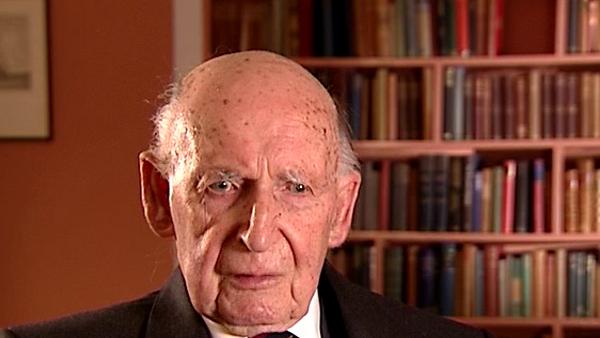NEXT STORY

Getting the funding for the MK I Radio Telescope
RELATED STORIES

NEXT STORY

Getting the funding for the MK I Radio Telescope
RELATED STORIES



I went to... I think at that stage, I did two things. I first of all went to see Sir Ben Lockspeiser, who was the Chairman of the Department of Scientific and Industrial Research, and it's... at some stage he said, 'Well, look here, how much is this going to cost?' And I said, 'We don't know, it might be £50,000, £100,000'. And he said, 'Well, look here, young man, I'll give you a small sum of money, and go away and find out how much it really would cost', a very wise statement.
At the same time... and so we then employed Husband to do a proper design study of this telescope, and I... which we had then agreed should be 250 feet in diameter. At about that same time, Blackett said, 'Now, we must get together the Astronomer Royal, Sir Harold Spencer-Jones, and the Astronomer Royal of Scotland, and Sir Edward Appleton', who had one of the foremost scientist, he had formerly been associated with the government administration of scientific research, and I had got to know him during the war. He had come to see some of my work. He had just been appointed Principal and Vice Chancellor of the University of Edinburgh.
And it was agreed that in order to obtain support for my project, Appleton agreed to hold a meeting in his rooms in Edinburgh. And one winter's day, in February, we assembled there – it was Blackett, Graves, who was the Astronomer Royal of Scotland, Spencer-Jones, and Hey, and Ryle sent his apologies, but nevertheless gave his support, and Ellison, who was then the Secretary of the Royal Astronomical Society, and one or two other people – and we explained to... I had sent a memorandum and circulated the memorandum on what the telescope might do, based on the work which I was supposed to do on the cosmic ray air showers, but also, then, picking up that threads of the cosmic radiation, which was then being rapidly developed, the study of which was then rapidly developing. I had also made calculations on the possibility of studying the moon and the nearer planets by radar, and we... Appleton said, 'Now, we will go around the table, and hear what everybody thinks of this project, and what's it going to do'. And we did that, and as the... we rotated again to the Chairman, Appleton, I held my breath, as to what he was going to say, and he said a most remarkable thing. He said, 'Well, I'm impressed by what Lovell says that he might be able to do with this telescope'. He said, 'But I am even more impressed by the future discoveries, which such an instrument might make'.
Well, that was an amazing statement. So we had at that time full authority, all the authority we could get for building this instrument. The question arose as to... Blackett warned me, on going to that meeting, he said, 'Now, look, remember, you are proposing to build a telescope for the country, not for yourself at Jodrell Bank. So just bear that in mind when you speak'. So I said, to the meeting, I said, 'This is a project for the United Kingdom', and the reaction was immediate. If we're going to build a telescope, we should build it where you're working, because, you know, you're the person who wants it. So that's how the telescope became eventually sited at Jodrell Bank, which was then, in fact, regarded as quite a good site, both climatically, and there was no electricity supply anywhere near it and very little traffic.
Bernard Lovell (1913-2012), British radio astronomer and founder of the Jodrell Bank Observatory, received an OBE in 1946 for his work on radar, and was knighted in 1961 for his contribution to the development of radio astronomy. He obtained a PhD in 1936 at the University of Bristol. His steerable radio telescope, which tracked Sputnik across the sky, is now named the Lovell telescope.
Title: A national project that gained the support of Edward Appleton
Listeners: Megan Argo Alastair Gunn
Megan Argo is an astronomer at the University of Manchester's Jodrell Bank Observatory researching supernovae and star formation in nearby starburst galaxies. As well as research, she is involved with events in the Observatory's Visitor Centre explaining both astronomy and the history of the Observatory to the public.
Alastair Gunn is an astrophysicist at Jodrell Bank Observatory, University of Manchester. He is responsible for the coordination and execution of international radio astronomical observations at the institute and his professional research concerns the extended atmospheres of highly active binary stars. Alastair has a deep interest and knowledge of the history of radio astronomy in general and of Jodrell Bank in particular. He has written extensively about Jodrell Bank's history.
Tags: MK I Radio Telescope, Astronomer Royal, Astronomer Royal of Scotland, University of Edinburgh, Edinburgh, Royal Astronomical Society, Jodrell Bank, United Kingdom, Patrick Blackett, Harold Spencer-Jones, Edward Appleton, Mervyn A Ellison
Duration: 4 minutes, 59 seconds
Date story recorded: January 2007
Date story went live: 05 September 2008